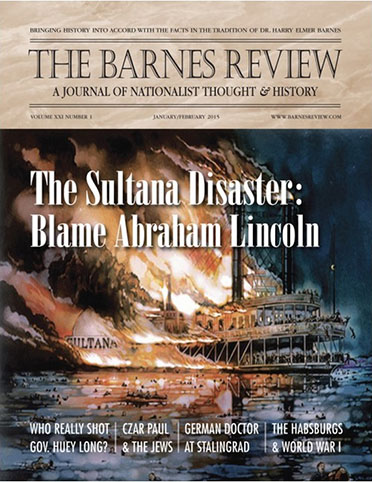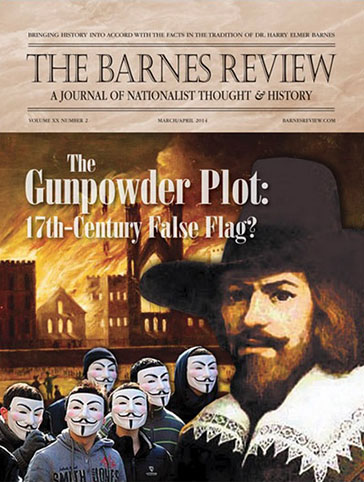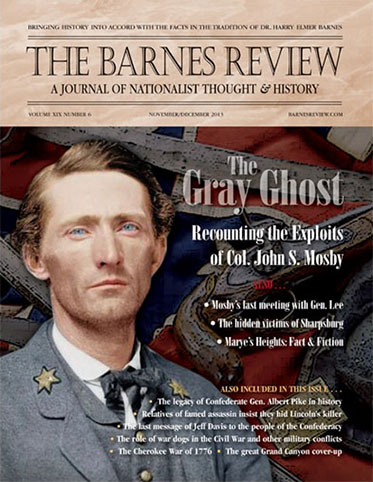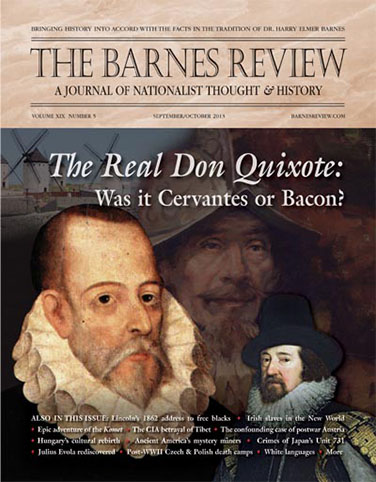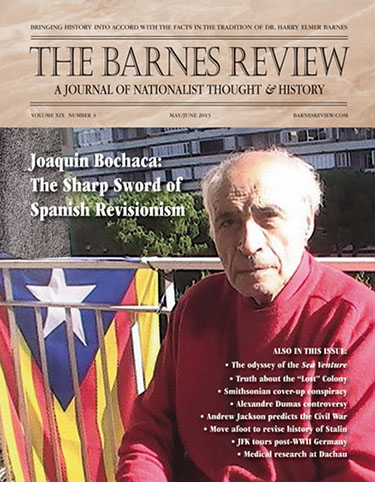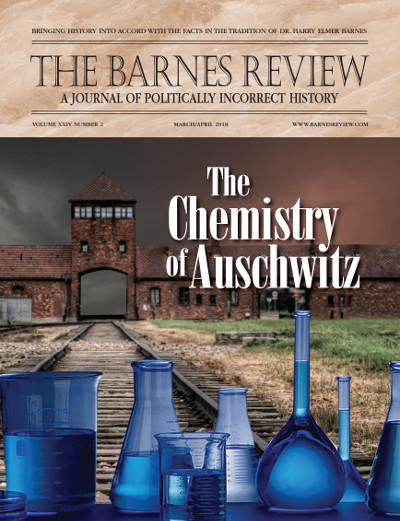
The Barnes Review March/April 2018
$5.00 – $10.00
The Barnes Review
A JOURNAL OF POLITICALLY INCORRECT HISTORY
MARCH/APRIL 2018 ❖ VOLUME XXIV ❖ NUMBER 2
TABLE OF CONTENTS
THE CHEMISTRY OF AUSCHWITZ
JEWISH SURVIVORS SPEAK FROM AUSCHWITZ-BIRKENAU
HÖSS CONFESSES TO EVERYTHING
WHY THE ALLIES WEAPONIZED THE HOLOCAUST NARRATIVE
THE MALMEDY WAR CRIMES TRIAL: WHY THE VERDICT WAS RIGHT
THE ARTIST WITHIN THE WARLORD
THE NUREMBERG STRANGLER
SAGA OF THE PARATROOPER GENERAL
THE TRIAL OF HERMANN RAMCKE
GERMANY’S CONSTITUTION A FLOP
- Description
- Additional information
Description
The Barnes Review
A JOURNAL OF POLITICALLY INCORRECT HISTORY
MARCH/APRIL 2018 ❖ VOLUME XXIV ❖ NUMBER 2
TABLE OF CONTENTS
THE CHEMISTRY OF AUSCHWITZ
BY JOHN WEAR, J.D. Were the facilities the Germans possessed in the 1940s practical—even suitable—for killing mass numbers of prisoners as described in mainstream history books? What remnants of the poisonous chemicals have been found in the chambers? What do Revisionists claim about the chemistry of Auschwitz-Birkenau concentration camp?
JEWISH SURVIVORS SPEAK FROM AUSCHWITZ-BIRKENAU
BY JOHN WEAR, J.D. The Court Historians assert that Germany’s WWII concentration camps were centers of mass slaughter, whereas Holocaust Revisionists say too many “useless eaters” were kept alive at great expense to justify that claim. Who did survive, and what did they say about their experiences?
HÖSS CONFESSES TO EVERYTHING
BY SANTIAGO ALVAREZ. If one has any doubts the Germans slaughtered millions of innocent people during WWII in poison gas chambers, or that the camps were no more than extermination centers, one need only look at the confessions of Auschwitz Commandant Rudolf Höss. He confessed to everything and more. But are his confessions truthful?
WHY THE ALLIES WEAPONIZED THE HOLOCAUST NARRATIVE
BY JOHN WEAR, J.D. As with any war, the victors write the history books with a keen eye toward whitewashing their own crimes and exaggerating the crimes of others. This was especially true after World War II due to the sheer volume of war crimes committed by the victors themselves.
THE MALMEDY WAR CRIMES TRIAL: WHY THE VERDICT WAS RIGHT
BY JOHN WEAR, J.D. Recently a would-be Revisionist scholar attempted to rewrite history and prove the verdicts in the Malmedy War Crimes Trial were too lenient. Here’s why he fell flat on his face.
THE ARTIST WITHIN THE WARLORD
BY PROFESSOR RAY GOODWIN. This longtime Texas-based teacher, scholar and author tells us why TBR’s new book, The Artist Within the Warlord: An Adolf Hitler You’ve Never Known, by Carolyn Yeager and Wilhelm Kriessmann, is must reading. Even Ray saw a few things he’d never seen in any other book.
THE NUREMBERG STRANGLER
BY CAROLYN YEAGER. After World War II ended, the Allies, bent on bringing vengeance down on the military and ideological leaders of a defeated enemy, convened a series of sham legal proceedings with predetermined outcomes. In the end, 11 men were doomed to hang. Luckily for the Allies, they had the perfect psychopath to carry out the deed.
SAGA OF THE PARATROOPER GENERAL
BY RONALD L. RAY. Though you may have never heard his name before, Hermann-Bernhard Ramcke was an eyewitness to, and a participant in, some of the most momentous events of WWII. After the war, he was accused of war crimes committed in Brest, incarcerated, escaped, returned voluntarily, was convicted and finally released. Here is Ramcke’s WWII saga—taken from his own words.
THE TRIAL OF HERMANN RAMCKE
BY V.J.P. VEALE. V.J.P. Veale is best known for his two-book set Advance to Barbarism, and Crimes Discreetly Veiled, written in the 1950s. In it he dedicated an entire section to the war crimes trial of Hermann-Bernhard Ramcke. Read what Veale thought about the proceedings.
GERMANY’S CONSTITUTION A FLOP
BY STEPHEN MITFORD GOODSON. A constitution for the Germans would be nice, thought the Allies in 1949. The Soviets were now the largest threat to the West, and a transition from military occupation to self-governance was needed in Germany. But few know about the secret agreement arranged the night before the constitution was signed—May 23, 1949—sealing Germany’s fate until 2099.
Additional information
| TBR Back Issue | PDF Copy, Print Copy |
|---|



